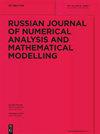关于INM-RAS气候模型中北冰洋气候状态的多年潜在可预测性
IF 0.6
4区 数学
Q4 MATHEMATICS, APPLIED
Russian Journal of Numerical Analysis and Mathematical Modelling
Pub Date : 2022-04-01
DOI:10.1515/rnam-2022-0010
引用次数: 1
摘要
摘要利用INM-RAS气候模型的理想化数值实验研究了北冰洋上层300米温度的潜在可预测性。研究表明,热含量可以预测长达4-6年。在温度和盐度出现正异常之前的几年里,大西洋流入北冰洋的水量超过了平均值。表面场,包括温度、盐度、冰的浓度和质量,比0-300米层的热含量更不可预测。本文章由计算机程序翻译,如有差异,请以英文原文为准。
On the multi-annual potential predictability of the Arctic Ocean climate state in the INM RAS climate model
Abstract Idealized numerical experiments with the INM RAS climate model are used to study the potential predictability of the temperature in the upper 300-meter layer of the Arctic Ocean. It is shown that the heat content can be predictable for up to 4–6 years. Positive anomalies of the temperature and salinity are preceded for several years by a state in which the influx of Atlantic water into the Arctic Ocean exceeds the average value. Surface fields, including temperature, salinity, concentration and mass of ice, are less predictable than the heat content in the layer of 0–300 meters.
求助全文
通过发布文献求助,成功后即可免费获取论文全文。
去求助
来源期刊
CiteScore
1.40
自引率
16.70%
发文量
31
审稿时长
>12 weeks
期刊介绍:
The Russian Journal of Numerical Analysis and Mathematical Modelling, published bimonthly, provides English translations of selected new original Russian papers on the theoretical aspects of numerical analysis and the application of mathematical methods to simulation and modelling. The editorial board, consisting of the most prominent Russian scientists in numerical analysis and mathematical modelling, selects papers on the basis of their high scientific standard, innovative approach and topical interest.
Topics:
-numerical analysis-
numerical linear algebra-
finite element methods for PDEs-
iterative methods-
Monte-Carlo methods-
mathematical modelling and numerical simulation in geophysical hydrodynamics, immunology and medicine, fluid mechanics and electrodynamics, geosciences.

 求助内容:
求助内容: 应助结果提醒方式:
应助结果提醒方式:


